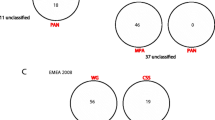Summary
We report three patients with a Sneddon syndrome in whom predominantly small (500–900 kD) IgM-containing serum immune complexes were detectable. Furthermore, antiphospholipid antibodies and increased von Willebrand factor antigen were found in the sera of two cases. Especially the data demonstrating small circulating immune complex as suggest that Sneddon's syndrome, a rare vasculitis disorder, might immunologically be characterized by circulating IgM-containing immune complexes which, in addition, could play a role in the pathogenesis of this disease entity. The elevated antiphospholipid antibodies as well as the increased von Willebrand factor antigen in the sera of the investigated patients have to be considered as nonspecific vasculitis-associated phenomena.
Similar content being viewed by others
References
Ehrmann S (1912) Weitere Mitteilungen über syphilitische Veränderungen der Hautgefäße und die damit zusammenhängenden Phänomene. Arch Derm Syph 113:261
Adamson HG (1912) Modern viewes upon the significance of skin eruptions. Lancet I:1041–1048
Church RE (1962) Reticular livedo with cerebro-vascular lesions. Br J Dermatol 74:156–157
Champion RH (1965) Livedo reticularis: A review. Br J Dermatol 77:167–179
Sneddon IB (1965) Cerebrovascular lesions and livedo reticularis. Br J Dermatol 77:180–185
Thomas DJ, Kirby JDT, Britten KE, Galton DJ (1982) Livedo reticularis and neurological lesions. Br J Dermatol 106:711–712
Lubach D, Stamm T (1981) Neurologische Veränderungen bei Livedo racemosa generalisata (Ehrmann). Hautarzt 32:245–248
Rumpl E, Rumpl H (1979) Recurrent transient global amnesia in a case with cerebrovascular lesion and livedo reticularis (Sneddon's syndrome). J Neurol 221:127
Rebello M, Val JF, Garijo F, Quintana F, Berciano J, Livedo syndrome. Brain 106:965–979
Rumpl E, Neuhofer J, Pallua A, Willeit J, Vogl G, Stampfel G, Platz T (1985) Cerebrovascular lesions and livedo reticularis (Sneddon's syndrome) — a progressive cerebrovascular disorder? J Neurol 231:324–330
Zubler RH, Lange G, Lambert PH, Miescher PA (1976) Detection of immune complexes in unheated sera by a modified 125J-C1q-binding test. J Immunol 116:232
Krapf FE, Rengert D, Schedel I, Leiendecker K, Leyssens H, Deicher H (1982) A PEG-precipitation laser nephelometer technique for detection and characterisation of circulating immune complexes in human sera. J Immunol Methods 54:107
Gharavi AE, Harris EN, Asherson RA, Hughes GRV (1987) Anticardiolipin antibodies: Isotype distribution and phospholipid specificity. Ann Rheum Dis 46:1–6
Cejka J (1982) Enzyme immunoassay for factor VIII-related antigen. Clin Chem 28:1356–1358
Jonas J, Kölble K, Völcker HE, Kalden JR (1986) Central retinal artery occlusion in Sneddon's disease associated with antiphospholipid antibodies. Am J Ophthalmol 102:37–40
Stephens WP, Ferguson JT (1982) Livedo reticularis and cerebrovascular disease. Postgrad Med J 58:70–73
Drake ME (1982) Winiwarter-Buerger disease (thrombangitis obliterans) with cerebral involvement. JAMA 248:1870–1872
Biller J, Asconape J, Challa VR, Toole JF, McLean WT (1981) A case for cerebral thrombangitis obliterans. Stroke 12:686–689
Pinol Aguade J, Ferrandiz C, Ferrer Roca O, Ingelmo M (1975) Livedo reticularis y accidentes cerebro-vasculares. Med Cutan Ibero Lat Am 3:257–265
Conley CL, Hartmann RC (1952) A hemorrhagic disorder caused by circulating anticoagulant in patients with disseminated lupus erythematosus. J Clin Invest 31:621–622
Mueh JR, Herbst KD, Rapaport SI (1980) Thrombosis in patients with the lupus anticoagulant. Ann Intern Med 92:156
Harris EN, Loizou S, Englert H, Derue G, Chan JK, Gharavi AE, Hughes GRV (1984) Anticardiolipin antibodies and lupus anticoagulant. Lancet 1099
Lubbe WF, Butler WS, Palmer SJ, Liggins GC (1984) Lupus anticoagulant in pregnancy. Br J Obstet Gynaecol 91:357
Harris EN, Gharavi AE, Hughes GRV (1985) Antiphospholipid antibodies. Clin Rheum Dis 11:591–609
Asherson RA, Mercey D, Phillips G, Sheehan N, Gharavi AE, Harris EN, Hughes GRV (1987) Recurrent stroke and multiinfarct dementia in systemic lupus erythematosus: association with antiphospholipid antibodies. Ann Rheum Dis 46:605–611
McHugh NJ, Maymo J, Skinner RP, James I, Maddison PJ (1988) Anticardiolipin antibodies, livedo reticularis, and major cerebrovascular and renal disease in systemic lupus erythematosus. Ann Rheum Dis 47:110–115
Anderson NE, Ali MR (1984) The lupus anticoagulant, pulmonary thrombembolism and fatal pulmonary hypertension. Ann Rheum Dis 43:760
Krapf FE (1984) Immunkomplexe: Entstehung, Eigenschaften, Bedeutung und Nachweis (Teil I und II). Lab Med 8:298–302, 341–345
Manger BJ, Krapf FE, Gramatzki M, Nüsslein HG, Burmester GR, Krauledat PB, Kalden JR (1985) IGE-containing circulating immune complexes in Churg-Strauß vasculitis. Scand J Immunol 21:369–373
Williams RC (1981) Immune complexes: a clinical perspective. Am J Med 71:743–746
WHO (1978) A WHO collaborative study for the evaluation of eighteen methods for detecting immune complexes in serum. J Clin Lab Immunol 1:1–3
Brinkhous KM, Sultzer DL, Reddick RL, Griggs TR (1980) Elevated plasma von Willebrand factor levels as an index of acute endothelial injury: use of a hypotonic injury model in rats. Fed Proc 39:630 (abstr)
Woolfe AD, Wakerley G, Wallington TB, Scott DGI, Dieppe PA (1987) Factor III related antigen in the assessment of vasculitis. Ann Rheum Dis 46:411–447
Author information
Authors and Affiliations
Rights and permissions
About this article
Cite this article
Schulze-Lohoff, E., Krapf, F., Bleil, L. et al. IGM-containing immune complexes and antiphospholipid antibodies in patients with Sneddon's syndrome. Rheumatol Int 9, 43–48 (1989). https://doi.org/10.1007/BF00270289
Received:
Accepted:
Issue Date:
DOI: https://doi.org/10.1007/BF00270289




